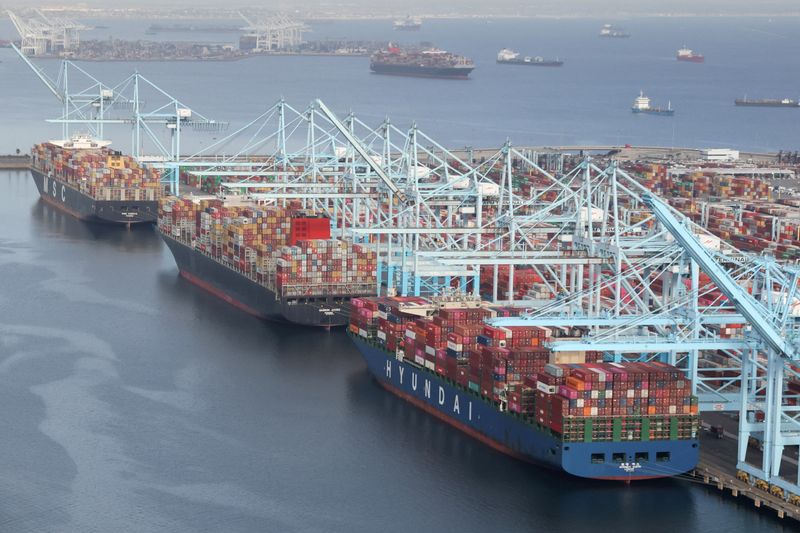By Lucia Mutikani
WASHINGTON (Reuters) - The U.S. trade deficit widened by the most in eight years in April as imports of goods rebounded while exports of energy products declined, a trend that if sustained, could result in trade being a drag on economic growth in the second quarter.
The increase reported by the Commerce Department on Wednesday was the biggest since April 2015 and pushed the trade gap to the highest level in six months. It led economists to expect that trade could chop off as much as 2.5 percentage points from gross domestic product this quarter, unless imports reversed course, a tall order given the persistent strength in domestic demand. A strong dollar and slowing global demand could curb exports.
"The terms of trade are worsening and this will bring down second-quarter estimates of real GDP growth closer to the 1% stall speed where bad things can happen and the economy can stumble and go over the cliff," said Christopher Rupkey, chief economist at FWDBONDS in New York.
The trade deficit jumped 23.0% to $74.6 billion. Data for March was revised to show the trade gap narrowing to $60.6 billion instead of the previously reported $64.2 billion. The government revised the goods trade data from 2018 while the trade services figures were revised from 2017.
Those revisions showed the trade deficit was not as large as previously thought in the first quarter. As a result, economists expect the government to raise its GDP growth estimate for the January-March quarter to as high as a 2.3% annualized rate when it publishes its third estimate later this month.
The revisions to the trade data followed on the heels of last week's solid construction spending data. The government's second estimate of first-quarter GDP last month showed trade made no contribution to the economy's 1.3% growth rate after adding to GDP for three straight quarters.
Adjusted for inflation, the goods trade deficit shot up 16.5% to $95.8 billion in April. Goldman Sachs (NYSE:GS) lowered its second-quarter GDP growth tracking estimate by half a percentage point to a 1.7% rate.
Stocks on Wall Street were trading mostly lower. The dollar slipped against a basket of currencies. U.S. Treasury prices fell.
EXPORTS PLUNGE
Goods imports rose 2.0% to $263.2 billion in April, boosted by motor vehicles, parts and engines. There were also increases in imports of industrial supplies and materials, though petroleum imports fell to the lowest level since August 2021.
Imports of consumer goods surged $1.8 billion, driven by cellphones and other household goods. Food imports were the lowest since December 2021. Imports of services decreased $0.4 billion to $60.4 billion, weighed down by declines in transport and travel. Overall imports increased 1.5% to $323.6 billion.
Exports of goods plunged 5.3%, the most in three years, to $167.1 billion. That was the lowest level since February 2022.
Exports are being crimped by slowing global demand. Though the dollar gave up some gains early in the year in the wake of 500 basis points worth of interest rate increases from the Federal Reserve since March 2022, the greenback has regained ground in recent weeks against the currencies of the United States' main trade partners. That trend could make U.S.-made goods less competitive on the global market in the months ahead.
"The recent strengthening in the trade-weighted U.S. dollar since mid-April will put further downward pressure on exports and upward pressure on imports," said Matthew Martin, a U.S. economist at Oxford Economics in New York. "Fluctuations in the dollar effect the trade deficit with a lag."
Contentious West Coast port labor negotiations, which have caused temporary disruptions could impact trade data in the coming months. More than 22,000 dockworkers at ports stretching from California to Washington state have been working without a contract since last July.
April's drop in goods exports was led by a sharp decline in exports of industrial supplies and materials, mostly crude oil and fuel oil. Exports of industrial supplies and materials, which include petroleum, were the lowest since November 2021.
There was also a big decline in exports of consumer goods. Exports of services, however, increased $0.2 billion to a record $81.9 billion, lifted by travel and other business services. But exports of financial services and government goods and services fell.
Overall exports fell 3.6%, the largest drop in three years, to $249.0 billion. That was the lowest level since March 2022. The services surplus was the highest since March 2021.
The nation's goods trade deficit with China widened to $24.2 billion in April from $22.6 billion in March.
